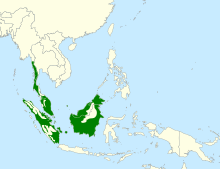| Black-and-yellow broadbill | |
|---|---|
| Male, female | |
| Scientific classification | |
| Domain: | Eukaryota |
| Kingdom: | Animalia |
| Phylum: | Chordata |
| Class: | Aves |
| Order: | Passeriformes |
| Family: | Eurylaimidae |
| Genus: | Eurylaimus |
| Species: | E. ochromalus
|
| Binomial name | |
| Eurylaimus ochromalus Raffles, 1822
| |

| |
| Black-and-yellow broadbill distribution | |
| Synonyms[2] | |
| |
The black-and-yellow broadbill (Eurylaimus ochromalus) is a species of bird in the typical broadbill family Eurylaimidae. A small, distinctive species, it has a black head, breastband, and upperparts, a white neckband, yellow streaking on the back and wings, and vinous-pink underparts that turn yellow towards the belly. The beak is bright blue, with a green tip to the upper mandible and black edges. It shows some sexual dimorphism, with the black breastband being incomplete in females.
Native to Brunei, Indonesia, Malaysia, Myanmar, Singapore, and Thailand, it inhabits evergreen forest, dipterocarp forest, swamp forest, heath forest, and forest edge, along with secondary forest and plantations that contain large trees. Mainly inhabiting lowlands, the species is found up to elevations of 1,220 m (4,000 ft). The black-and-yellow broadbill is mainly insectivorous, but also feeds on molluscs and incidentally takes fruit.
The black-and-yellow broadbill breeds during the dry season throughout its range, with both sexes helping build a large, untidy, pear-shaped nest out of moss, fungal mycelia, and leaves. Eggs are laid in clutches of two or three, sometimes containing a fourth runt egg, and are incubated by both sexes. The species is listed as near-threatened by the IUCN because of a decline in its population caused by habitat loss.
- ^ BirdLife International (2017). "Eurylaimus ochromalus". IUCN Red List of Threatened Species. 2017: e.T22698735A110680385. doi:10.2305/IUCN.UK.2017-1.RLTS.T22698735A110680385.en. Retrieved 12 November 2021.
- ^ Dekker, René W. R. J.; Dickinson, Edward C.; Eck, Siegfried; Somadikarta, Soekarja (2000). "Systematic notes on Asian birds. 3. Types of the Eurylaimidae" (PDF). Zoologische Verhandelingen (331): 77–88. ISSN 0024-1652. Archived (PDF) from the original on 11 May 2021. Retrieved 14 December 2021.


